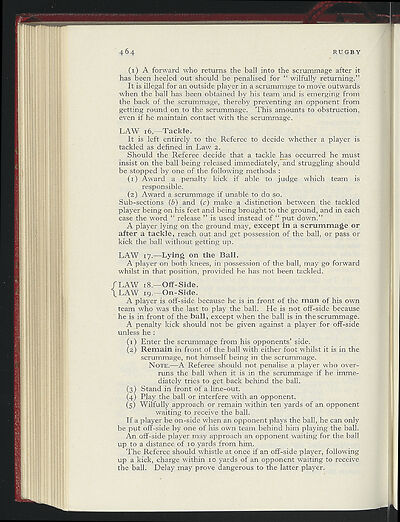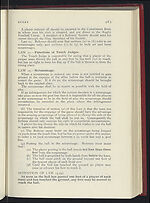1938-39
(492)
Download files
Complete book:
Individual page:
Thumbnail gallery: Grid view | List view

I
4
6
4
RUGBY
(i)
A forward who returns the ball into the scrummage after it
has been heeled out should be penalised for " wilfully returning."
It is illegal for an outside player in a scrummage to move outwards
when the ball has been obtained by his team and is emerging from
the back of the scrummage, thereby preventing an opponent from
getting round on to the scrummage. This amounts to obstruction,
even if he maintain contact with the scrummage.
LAW 16.—
Tackle.
It is left entirely to the Referee to decide whether a player is
tackled as defined in Law
2.
Should the Referee decide that a tackle has occurred he must
insist on the ball being released immediately, and struggling should
be stopped by one of the following methods :
(i) Award a penalty kick if able to judge which team is
responsible.
(2)
Award a scrummage if unable to do so.
Sub-sections (b) and (c) make a distinction between the tackled
player being on his feet and being brought to the ground, and in each
case the word " release " is used instead of " put down."
A player lying on the ground may,
except in
a
scrummage or
after
a tackle, reach out and get possession of the ball, or pass or
kick the ball without getting up.
LAW
17.
—Lying
on the Ball.
A player on both knees, in possession of the ball, may go forward
whilst in that position, provided he has not been tackled.
JLAW i8.—
Off-Side.
I
LAW i g.
—On- Side.
A player is off-side because he is in front of the
man
of his own
team who was the last to play the ball. He is not off-side because
he is in front of the ball, except when the ball is in the scrummage.
A penalty kick should not be given against a player for .off-side
unless he :
(i) Enter the scrummage from his opponents' side.
(z)
Remain
in front of the ball with either foot whilst it is in the
scrummage, not himself being in the scrummage.
N
OTE.
—A Referee should not penalise a player who over-
runs the ball when it is in the scrummage if he imme-
diately tries to get back behind the ball.
(3) Stand in front of a line-out.
(4) Play the ball or interfere with an opponent.
(5) Wilfully approach or remain within ten yards of an opponent
waiting to receive the ball.
If a player be on-side when an opponent plays the ball, he can only
be put off-side by one of his own team behind him playing the ball.
An off-side player may approach an opponent waiting for the ball
up to a distance of io yards from him.
The Referee should whistle at once if an off-side player, following
up a kick, charge within io yards of an opponent waiting to receive
the ball. Delay may prove dangerous to the latter player.
4
6
4
RUGBY
(i)
A forward who returns the ball into the scrummage after it
has been heeled out should be penalised for " wilfully returning."
It is illegal for an outside player in a scrummage to move outwards
when the ball has been obtained by his team and is emerging from
the back of the scrummage, thereby preventing an opponent from
getting round on to the scrummage. This amounts to obstruction,
even if he maintain contact with the scrummage.
LAW 16.—
Tackle.
It is left entirely to the Referee to decide whether a player is
tackled as defined in Law
2.
Should the Referee decide that a tackle has occurred he must
insist on the ball being released immediately, and struggling should
be stopped by one of the following methods :
(i) Award a penalty kick if able to judge which team is
responsible.
(2)
Award a scrummage if unable to do so.
Sub-sections (b) and (c) make a distinction between the tackled
player being on his feet and being brought to the ground, and in each
case the word " release " is used instead of " put down."
A player lying on the ground may,
except in
a
scrummage or
after
a tackle, reach out and get possession of the ball, or pass or
kick the ball without getting up.
LAW
17.
—Lying
on the Ball.
A player on both knees, in possession of the ball, may go forward
whilst in that position, provided he has not been tackled.
JLAW i8.—
Off-Side.
I
LAW i g.
—On- Side.
A player is off-side because he is in front of the
man
of his own
team who was the last to play the ball. He is not off-side because
he is in front of the ball, except when the ball is in the scrummage.
A penalty kick should not be given against a player for .off-side
unless he :
(i) Enter the scrummage from his opponents' side.
(z)
Remain
in front of the ball with either foot whilst it is in the
scrummage, not himself being in the scrummage.
N
OTE.
—A Referee should not penalise a player who over-
runs the ball when it is in the scrummage if he imme-
diately tries to get back behind the ball.
(3) Stand in front of a line-out.
(4) Play the ball or interfere with an opponent.
(5) Wilfully approach or remain within ten yards of an opponent
waiting to receive the ball.
If a player be on-side when an opponent plays the ball, he can only
be put off-side by one of his own team behind him playing the ball.
An off-side player may approach an opponent waiting for the ball
up to a distance of io yards from him.
The Referee should whistle at once if an off-side player, following
up a kick, charge within io yards of an opponent waiting to receive
the ball. Delay may prove dangerous to the latter player.
Set display mode to:
![]() Universal Viewer |
Universal Viewer | ![]() Mirador |
Large image | Transcription
Mirador |
Large image | Transcription
| Games and sports in the army > 1938-39 > (492) |
|---|
| Permanent URL | https://digital.nls.uk/248743002 |
|---|
| Description | 'Games and Sports in the Army' was an annual publication produced by the British War Office between the 1930s and 1960s. This included the Second World War. It outlines the rules and regulations for games and sports played by members of the armed forces. It features names and photographs of team members, and examples of contemporary advertising. |
|---|---|
| Shelfmark | GWB.52 |

